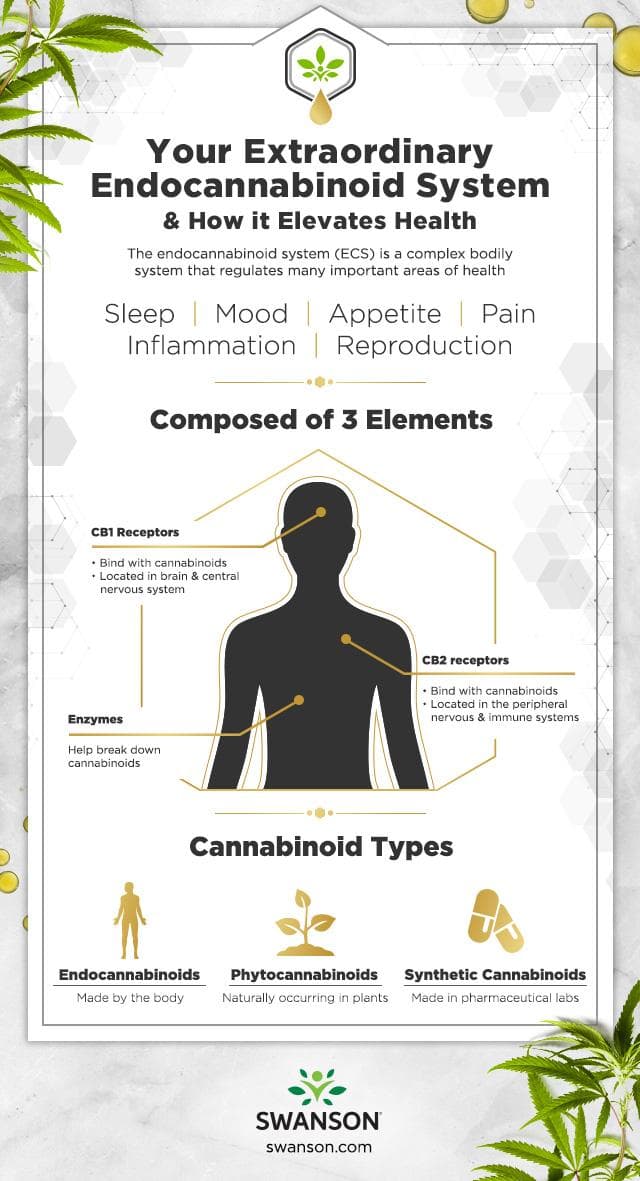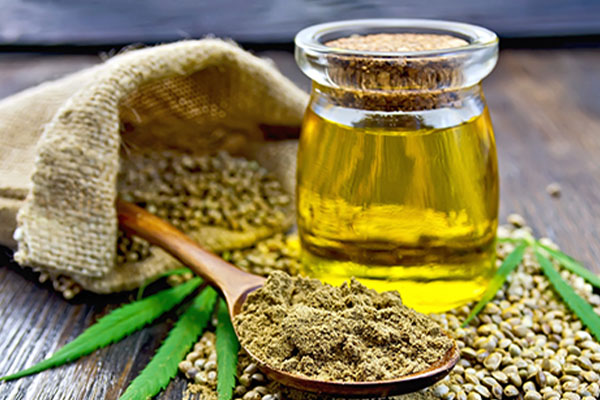Your Endocannabinoid System: What it is and How it Works
If you’re thinking about diving into the exciting world of cannabidiol (CBD) hemp extracts to promote your overall wellbeing, you’re not alone!
Thanks to its speedy growth in popularity, CBD hemp extracts are now easily accessible in oil tinctures, gummies, softgels, capsules, skin balms and more.
But before you start using CBD, it’s important to first understand how it reacts inside your body and why, which all comes down to your endocannabinoid system.

The Endocannabinoid System
The endocannabinoid system (ECS) was discovered in the 1990s by research scientists trying to find an explanation for why tetrahydrocannabinol (THC) in cannabis plants creates a psychoactive effect in the human brain.1
They first identified the structure and function of the cannabinoid receptor CB1, which is what THC binds with to create a psychoactive “high.”15
Researchers then discovered cannabinoid receptor CB2, functioning primarily in the immune and digestive systems. From there, scientists pushed further to understand why the body would have such receptors, which is when they stumbled upon a complex network of cannabinoid receptors in the cells of the central and peripheral nervous systems.
They officially named this network the endocannabinoid system.2
All these years later, scientists’ understanding of the ECS is still limited, but we do know that it helps the body maintain vital physiological functions.3
It promotes homeostasis, the body’s sense of internal balance among its various systems, by regulating things like sleep, mood, appetite, pain, inflammation and reproduction.4
Because it creates this balance inside the body, the ECS also plays a clear role in overall wellbeing and many areas of health, including healthy aging.5
The ECS is composed of three elements: endocannabinoids, receptors (CB1 and CB2) that bond with endocannabinoids, phytocannabinoids and cannabinoids; and enzymes that help break down endocannabinoids and cannabinoids so they can bind with the receptors.6
Endocannabinoids are cannabinoid-like neurotransmitters that the body makes. They're the most abundant type of molecules in the body that bind to receptors.
The first and most prominent endocannabinoid discovered is called anandamide, and it acts on both CB1 and CB2 receptors, affecting both the central and peripheral nervous systems.
Anandamide has the most receptors in the brain, which are critical for the maintenance of the central nervous system.
Scientists have found that consistent aerobic exercise can help the body produce more anandamide, which then binds to CB1 and produces a calming effect as an enzyme called fatty acid amide hydrolase (FAAH) breaks it down.7
Eating foods rich in omega-3 fatty acids like fish, flax and hemp has also proven to support endocannabinoid signaling.8
CBD Hemp Extract & the Endocannabinoid System
Naturally-occurring CBD is the most prominent phytocannabinoid (a cannabinoid stemming from plants) identified by scientists thus far. Plenty of other cannabinoids exist alongside it, such as cannabichromene (CBC), cannabigerol (CBG) and cannabinol (CBN). CBD is simply the most well-known and understood among these.
It’s commonly derived from various species of cannabis, but hemp specifically contains a high content of CBD while also maintaining very low (less than .3%) to undetectable levels of THC.
Research today shows that small doses of phytocannabinoids from hemp and other plants can help support the body’s endocannabinoid system and the signals it sends through the peripheral and central nervous systems.9
Both CBD and THC bind to CB2 receptors in a similar way, but they have opposite reactions to CB1 receptors.10
While THC binds directly with CB1, sending a signal to the brain that results in a “high” effect, CBD can’t bond directly with CB1.
Instead, it negates any existing bonds between THC and CB1, maintaining the vital functions of the endocannabinoid system without creating psychoactive effects.
CBD also prevents the fatty acid amide hydrolase (FAAH) enzyme from breaking down anandamide in the brain, so the anandamide has a chance to make more of an impact.
CBD Sources
As mentioned previously, the most common source of naturally-occurring CBD used today comes from the hemp plant.
The 2018 Farm Bill officially classified “hemp” as cannabis varieties that, when dry, contain no more than .3% THC.11
Hemp can have low to undetectable levels of THC while also containing a bounty of beneficial CBD, which is why hemp plants are now used in all sorts of wellbeing-promoting products.
Other non-hemp CBD sources include the peels of citrus fruits like oranges and evergreen tree bark.16
Researchers have also started working on a way to derive CBD from a specific type of yeast similar to how we leaven bread and brew beer.12
They combine the yeast with genes from cannabis plants, and then the enzymes in the yeast produce CBD as heat is applied to the mixture.
3 Hemp-Based CBD Classifications
One final thing to note about your CBD hemp extract options is how product labeling differs and why. There are three classifications for hemp-derived CBD: full spectrum CBD, broad-spectrum CBD and CBD isolate.
- Full spectrum CBD hemp extract refers to hemp oil enriched with CBD, terpenes and other cannabinoids (including trace amounts of THC) in ratios that were naturally occurring in the original plant.
- Broad spectrum CBD hemp extract contains a variety of terpenes and cannabinoids but without trace amounts of THC.17 Some manufacturers also add terpenes and other cannabinoids in isolated forms to increase the product’s overall potency. Manufacturers can (and should) tell you exactly which terpenes and cannabinoids their products contain with the use of third-party laboratory testing.
- CBD isolate is the purest form of CBD hemp extract because it’s isolated and purified to reach the maximum concentration of CBD specifically. The result is a 99% pure CBD extract with low to no THC content.
These distinctions are important due to varying laws among the states, as well as the unique needs of different CBD hemp extract consumers.
The classifications are also a clear picture of why farmers and researchers are continuously exploring new means of growing and deriving CBD from hemp and alternative plants.
If you found this article to be helpful, you might also enjoy CBD vs THC: Everything You Need to Know and 14 Adaptogenic Herbs for Healthy Stress Support. Also, be sure to sign up for Swanson Health Emails to get expert wellness advice and our best promotions in your inbox.

About Lindsey Toth, MS, RD
Lindsey is a nationally recognized registered dietitian and nutritionist with a soft spot for pie. She empowers people to take charge of their health by finding the balance between the pleasure and nourishment in food. Her philosophy is that you should take care of your body because it’s the only permanent home you have. It’s what inspired her to pursue a career in nutrition.
*These statements have not been evaluated by the Food and Drug Administration. These products are not intended to diagnose, treat, cure, or prevent any disease.
Sources
1. Structure of Cannabinoid Receptor. National Library of Medicine. Read source
2. Endocannabinoid System. National Library of Medicine. Read source
3. The Endocannabinoid System. National Library of Medicine. Read source
4. Endocannabinoid Signaling. National Library of Medicine. Read source
5. The Endocannabinoid System. ScienceDirect. Read source
6. The Endocannabinoid System. National Library of Medicine. Read source
7. Cannabinoid Receptors. National Library of Medicine. Read source
8. Nutritional Omega-3. National Library of Medicine. Read source
9. Neurological Benefits of Phytocannabinoids. National Library of Medicine. Read source
10. Cannabis, Cannabinoids, and Health. National Library of Medicine. Read source
11. Hemp Production and the 2018 Farm Bill. FDA. Read source
12. CBD and THC. WIRED. Read source
13. Marinol. FDA. Read source
14. Epidiolex. FDA. Read source
15. Cannabinoids and Pain. Frontiers in Pharmacology. Read source
16. An Alt CBD. Source Weekly. Read source
17. Briad-Spectrum CBD. Medical News Today. Read source




